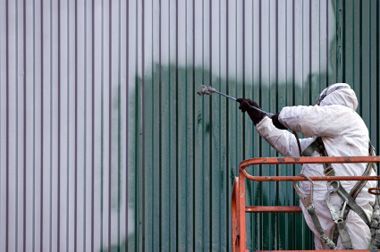Quality Paint Coating Products for Industrial Situations
Industrial equipment, machinery, and structures are exposed to many harsh environmental and physically demanding situations. Chemicals, extreme temperatures, and weather are just some of the conditions that can potentially corrode or degrade metallic and non-metallic materials. A paint coating applied to exposed surfaces is an economical protection method to reduce repair and replacement costs and to extend the durability and useable life of the devices and structures.
Chemistry and technology advancements have resulted in the development of many types of paint formulations that can endure harsh conditions in nearly every environment in the world. Paint is available in countless colours, along with many sheens and textures to meet the needs of your project.

A commercial painter on an industrial lift spray painting a steel exterior wall or duct.
Industrial paints include, but are not limited to the following types of formulations:
- Abrasion and scratch resistant
- Anti-microbial
- Chemical resistant, various chemical classes
- Cold-resistant
- Color fade resistant
- Enamels
- Epoxies
- Graffiti-resistant
- Heat-resistant
- Mold and mildew resistant
- Oil-resistant
- Rust-inhibiting
- Slip-reduction / textured paint
- Stain-resistant
- Surface primers
- Water-resistant / waterproof
Each of these paint types is formulated for endurance and protection of your valuable equipment, machinery, and structures. They also contribute to worker and environmental and public health and safety.
A coating on publicly accessible or visible functional and utilitarian structures such as bridges, motorway signs and fixtures, overpasses, promenades, and other structures provides visual appeal. Structure protection also saves the taxpayers money on repair, replacement, and restoration costs of corroded or degraded devices.
Before paint is applied, the surfaces must be completely clean and free of any impurities or residues. All grease, oil, old paint, rust, and other coatings must be removed to expose the bare surface of the material undergoing restoration and protective treatments.
The application of a primer and protective coatings is an easy and relatively inexpensive process to protect equipment, machinery, and structures from harsh environmental conditions, physical wear, and weathering. It is much more economical to restore and protect your valuable investments, rather than incurring replacement costs. The right choice of paint also adds visual appeal for a clean and professional look. Contact a professional paint specialist to assist you and your clients to choose the correct formulation to suit your project.
References
“Abrasive blasting”
http://en.wikipedia.org/wiki/Abrasive_blasting
Accessed 24 OCT 2011
“Abrasive Blasting and Applications of Protective Coatings”. Diamond PCS.
http://diamondpcs.com.au/pop_abrasiveblast.html
Accessed 17 OCT 2011
“Abrasive Blasting”. Centers for Disease Control and Prevention.
http://www.cdc.gov/niosh/topics/blasting/
Accessed 17 OCT 2011
“Abrasive Blasting Operations. Engineering Control and Work Practice Method”. Enviro-Management & Research Inc., Washington, D.C. Final Report. U.S. Dept of Health Education, and Welfare. March 1976.
http://www.cdc.gov/niosh/docs/76-179/pdfs/76-179.pdf
Accessed 17 OCT 2011
Coatings Advisor
http://www.coatingsadvisor.com/
http://www.coatingsadvisor.com/listings89.html
Accessed 22 OCT 2011
General Services Brochure. The Society for Protective Coatings
http://www.sspc.org/media/documents/general_services_brochure.pdf
Accessed 18 OCT 2011
“Ilmenite”. Mineral Zone.
http://www.mineralszone.com/minerals/ilmenite.html
Accessed 17 OCT 2011
“Industrial Abrasives”. Abrasive Technology. http://www.abrasive-blasting.net/
Accessed 17 OCT 2011
“Industrial Coating”
http://en.wikipedia.org/wiki/Protective_coatings
Accessed 20 OCT 2011
Industrial Coatings Information
Accessed 20 OCT 2011
Metal Coatings Corp.
Accessed 20 OCT 2011
The Ingredients of Paint and Their Impacts on Paint http://www.industrialpaintquality.com/pdfs/ingredientsofpaint.pdfProperties
Accessed 26 OCT 2011
The Society for Protective Coatings
Accessed 18 OCT 2011
Tnemec Company
http://www.tnemec.com/product/
Accessed 26 2011
Mon - Thu: 8:00 am - 4:00 pm • Fri: 8:00 am - 12:00 pm • Sat - Sun: Closed
16 Fursden Street, Glenella QLD 4740
